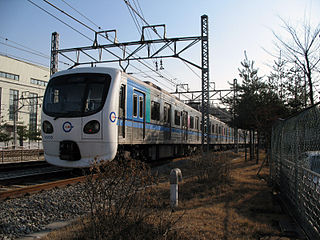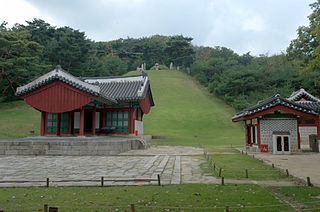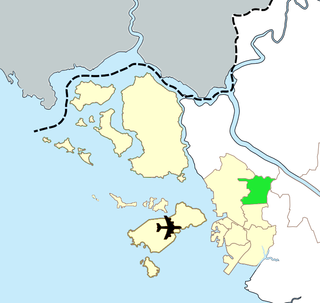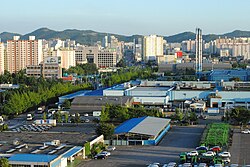
Incheon, formerly Jemulpo or Chemulp'o (제물포) until the period after 1910, officially the Incheon Metropolitan City, is a city located in northwestern South Korea, bordering Seoul and Gyeonggi to the east. Inhabited since the Neolithic, Incheon was home to just 4,700 people when it became an international port in 1883. Today, about 3 million people live in the city, making it South Korea's third-most-populous city after Seoul and Busan.
Gimpo is a city in Gyeonggi Province, South Korea. It borders Incheon, with which it shares the South Korean side of the Han River estuary, as well as Seoul and the lesser cities of Paju and Goyang. North Korea is across the Han River. The current mayor is Jeong Hayoung. The city's population of more than 300,000 is made up of more than 71,000 households.

Gyeonggi-do is the most populous province in South Korea. Its name, Gyeonggi, means "京 (Seoul) and 畿 ". Thus, Gyeonggi-do can be translated as "Seoul and the surrounding areas of Seoul". Seoul, the nation's largest city and capital, is in the heart of the area but has been separately administered as a provincial-level special city since 1946. Incheon, the nation's third-largest city, is on the coast of the province and has been similarly administered as a provincial-level metropolitan city since 1981. The three jurisdictions are collectively referred to as Sudogwon and cover 11,730 km2 (4,530 sq mi), with a combined population of 25.5 million—amounting to over half of the entire population of South Korea.

Bucheon is a city in Gyeonggi Province, South Korea. Bucheon is located 25 kilometers (16 mi) away from Seoul, of which it is a satellite city. It is located between Incheon and Seoul.

Gwangmyeong is a city in Gyeonggi Province, South Korea. It borders Seoul to the east, north and northeast, Anyang to the southeast, Siheung to the southwest, and Bucheon to the northeast.

Incheon Subway Line 1 is a 29.4-kilometer (18.3 mi) north-south subway line, part of the Incheon Subway system. The line is also included as a part of the overall Seoul Metropolitan Subway network; Bupyeong Station has a free transfer with Seoul Subway Line 1, Gyeyang Station connects with the AREX Line which leads to Incheon International Airport and Seoul Station, Bupyeong-gu Office Station has a free transfer with Seoul Subway Line 7, and Woninjae Station has a free transfer with the Suin Line.
Hyundai Department Store, together with Lotte Department Store and Shinsegae, is one of the three major department store chains in South Korea. Its parent company is the Hyundai Department Store Group.

Seoul Buses are public transit buses operated by the Seoul Metropolitan Government and/or private bus operators.

Seocho District (Korean: 서초구) is one of the 25 gu which make up the city of Seoul, South Korea. Seocho is generally referred to as a part of Greater Gangnam Area, along with Gangnam District. As of 2022, Seocho District ranks as the richest neighborhood in South Korea and among the most expensive areas in Seoul with an average sales price of 47.75 million South Korean won per 3.3 square meters. South Korea's rich are concentrated in the three Gangnam districts including Seocho, known as Gangnam School District Eight(강남 8학군).

Guro District (Guro-gu) is a district of Seoul, South Korea, which was separated from Yeongdeungpo District on April 1, 1980. Located in the southwestern part of the city, where besides Yangcheon District and Geumcheon District Guro District has an important position as a transport link which contains railroads, land routes from the rest of Seoul to the south of the country. The Gyeongbu and Gyeongin railway lines connect Seoul to Busan and Incheon. In addition, Seoul Metropolitan Subway lines 1, 2, and 7, and major highways intersect in Guro District.

Seongbuk District (Seongbuk-gu) is one of the 25 gu which make up the city of Seoul, South Korea. It is located in the mid-north part of the city. The current Mayor is Kim Young-bae (김영배), who has been mayor since July 1, 2010. Seongbuk-gu was established under Presidential Decree No. 159 on August 13, 1949, and was promoted to a autonomous district by implementing a Gu-level local government on May 1, 1988.

Gangseo District (Gangseo-gu) is one of the 25 wards (gu) of Seoul, South Korea. It is located on the south side of the Han River. Gimpo Airport is in Gonghang-dong, where many flights fly to cities like Busan, Jeju, and Gwangju.

Seo District (Seo-gu) is the largest district in Incheon, South Korea. It has an area 111.2 square kilometres (42.9 sq mi), and it has the largest area of farmland in Incheon.

Gyeyang District (Gyeyang-gu) is a ward in Incheon, South Korea.

National Route 6 is a major highway on the Korea It connects Incheon with the city of Gangneung, Gangwon Province,

The Seoul Capital Area (SCA), Sudogwon or Gyeonggi region, is the metropolitan area of Seoul, Incheon, and Gyeonggi Province, located in north-west South Korea. Its population of 26 million is ranked as the fifth largest metropolitan area in the world. Its area is about 12,685 km2 (4,898 sq mi). It forms the cultural, commercial, financial, industrial, and residential center of South Korea. The largest city is Seoul, with a population of approximately 10 million people, followed by Incheon, with 3 million inhabitants.
The 1995 municipal annexation in South Korea was an administrative event in which many cities and counties joined together into "urban-rural integrated" (도농복합시) cities as of 1 January 1995. Some of the annexation were done later as of 10 May 1995. Some of the counties were annexed to certain metropolitan cities(광역시) as of 1 March 2015.
The Gimpo Peninsula is a peninsula on the west coast of South Korea, occupied by most of Gimpo and Geomdan Dong and a portion of Gyeyang District in Incheon.

Keiki-dō is a former Korean province, one of the administrative divisions of Chōsen, with its capital at Keijō. The province consisted of what is now the South Korean territories of Seoul and Gyeonggi, as well as parts of what is now southern North Korea.
Gyeongginambu is a proposed province of South Korea that would span the contiguous Southern portion of Gyeonggi Province. Its name, Gyeonggi means "the area surrounding capital". Thus Gyeonggi-do can be translated as "province surrounding Seoul". Southern Gyeonggi Province is the portion of the South Korean Gyeonggi Province south of the Han River and Bukhan River.


















